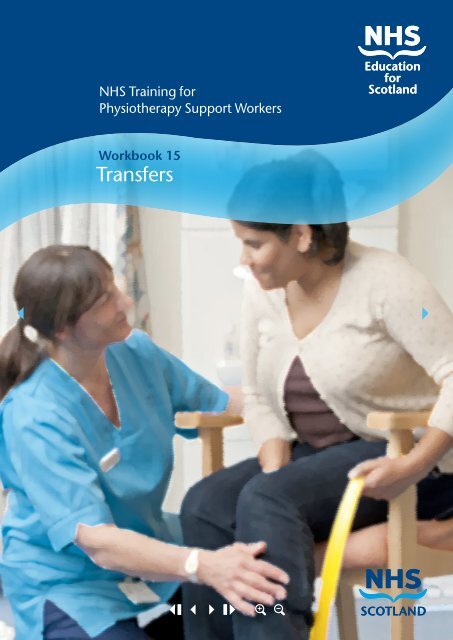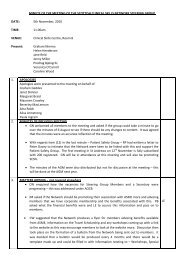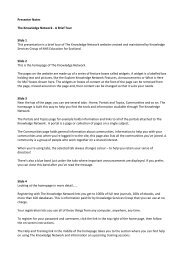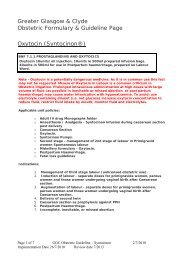Workbook 15 Transfers
Workbook 15 Transfers
Workbook 15 Transfers
Create successful ePaper yourself
Turn your PDF publications into a flip-book with our unique Google optimized e-Paper software.
NHS Training for<br />
Physiotherapy Support Workers<br />
<strong>Workbook</strong> <strong>15</strong><br />
<strong>Transfers</strong>
Contents<br />
<strong>Workbook</strong> <strong>15</strong> <strong>Transfers</strong> 1<br />
<strong>15</strong>.1 Aim 3<br />
<strong>15</strong>.2 Learning outcomes 3<br />
<strong>15</strong>.3 Lying–sitting transfer 4<br />
<strong>15</strong>.4 Teaching a patient to move up and down the bed 7<br />
<strong>15</strong>.5 Wheelchairs 8<br />
<strong>15</strong>.6 Teaching patients to transfer safely in and out of a bed or chair 9<br />
<strong>15</strong>.7 Teaching a patient to manoeuvre a wheelchair 11<br />
<strong>15</strong>.8 <strong>Transfers</strong> workbook completion 12<br />
<strong>15</strong>.9 <strong>Transfers</strong> reflection 13<br />
© NHS Education for Scotland 2012. You can copy or reproduce the information in this<br />
document for use within NHSScotland and for non-commercial educational purposes.<br />
Use of this document for commercial purposes is permitted only with the written<br />
permission of NES.
NHS Training for Physiotherapy Support Workers<br />
<strong>Workbook</strong> <strong>15</strong> | <strong>Transfers</strong><br />
<strong>Workbook</strong> <strong>15</strong><br />
<strong>Transfers</strong><br />
<strong>15</strong>.1 Aim<br />
The aim of this workbook is to provide the Healthcare Support Worker (HCSW)<br />
with the knowledge and skills required to help patients transfer.<br />
<strong>15</strong>.2 Learning outcomes<br />
By the end of this workbook you will be able to:<br />
■■<br />
■■<br />
■■<br />
Describe, demonstrate and teach the normal sequencing of movement to assist or<br />
facilitate bed mobility with patients.<br />
Assist in teaching patients to transfer safely in and out of a wheelchair using<br />
appropriate aids and from different surfaces and be able to dismantle and<br />
reconstruct a wheelchair for transportation.<br />
Manoeuvre a chair and carry out prescribed practice of manoeuvres with a patient.<br />
<strong>Workbook</strong> <strong>15</strong> Page 3
NHS Training for Physiotherapy Support Workers<br />
<strong>Workbook</strong> <strong>15</strong> | <strong>Transfers</strong><br />
<strong>15</strong>.3 Lying–sitting transfer<br />
As therapists, one of the most important parts of our role is to promote physical<br />
independence.<br />
As a support worker, you may be involved in practicing everyday tasks with a patient to<br />
enable them to be independent again.<br />
A simple but important task is the ability to move around the bed and get in and out.<br />
There are aids to assist with this if required, but our concern here is to assist a patient to get<br />
up from lying by re-educating a normal sequence of movement.<br />
You would only do these activities with a patient who has been assessed as capable by<br />
the therapist. You must not attempt this with a patient who cannot participate.<br />
Activity<br />
With your supervising therapist, have a look at how you would sit up to sit from lying on<br />
your back. Watch a couple of colleagues do the movement.<br />
Describe what they do<br />
You may notice that the person turns their head to the side, then rolls over bringing the rest<br />
of their body with them, whilst pushing up onto the elbow, sitting up and swinging the legs<br />
over the side of the bed.<br />
There will be variations – some will do it differently, but the components above<br />
are common.<br />
<strong>Workbook</strong> <strong>15</strong> Page 4
NHS Training for Physiotherapy Support Workers<br />
<strong>Workbook</strong> <strong>15</strong> | <strong>Transfers</strong><br />
Activity<br />
Watch your supervising therapist teach a patient how to get out of bed to sit on the side<br />
in this way.<br />
Once you are ready, your supervisor will watch and correct as you teach a patient to get<br />
up from lying in this way.<br />
Describe the instructions you gave to the patient<br />
You may tell them to:<br />
■■<br />
turn their head and reach over the side of the bed to turn onto their side<br />
■■<br />
now to lift their head up and push onto their elbow<br />
■■<br />
now swing their legs over the side and come up to sit<br />
The patient may get stuck at any one of these stages; therefore you should know where to<br />
place your hands to assist.<br />
You may also need someone on the bed behind the patient when they get to sitting, to<br />
ensure that the patient does not fall backwards.<br />
You must ensure that:<br />
your own position is safe<br />
that you are working within your base of support<br />
your spine is in a line<br />
the bed is at the right height to ensure that you are not flexing too much<br />
■■<br />
■■<br />
■■<br />
■■<br />
You may wish to assist the patient by placing your hands at the shoulder girdle and pelvis to<br />
assist them to roll over.<br />
<strong>Workbook</strong> <strong>15</strong> Page 5
NHS Training for Physiotherapy Support Workers<br />
<strong>Workbook</strong> <strong>15</strong> | <strong>Transfers</strong><br />
Activity<br />
Practice this with a model, try assisting them to roll over.<br />
You will notice that by placing your hands on their pelvis and shoulder, you can bring<br />
them on to their side more easily.<br />
You may need to assist to bring the legs over the side also.<br />
From your manual handling training, what handling aids might you use to assist a<br />
patient to come out of bed independently?<br />
■■<br />
A fabric turntable or a slide sheet under the patient’s hips may assist them to sit round<br />
over the side.<br />
■■<br />
A slide sheet under the legs may assist the patient to bring them over the side of the bed.<br />
Evidence<br />
Provide an example of having practiced lying to sitting or sitting to lying with a patient in<br />
the gym or on the ward.<br />
Describe what you told the patient to do and what aids you used and why<br />
What went well, what went not so well, what would you do differently next time?<br />
<strong>Workbook</strong> <strong>15</strong> Page 6
NHS Training for Physiotherapy Support Workers<br />
<strong>Workbook</strong> <strong>15</strong> | <strong>Transfers</strong><br />
<strong>15</strong>.4 Teaching a patient to move up and down the bed<br />
One difficult movement for patients can be moving up the bed in a seated position. You<br />
may be required to assist the patient to do this prior to carrying out some therapy.<br />
Again this can be done with one or two members of staff depending on the outcome of your<br />
risk assessment. Remember to speak to the patient and the nurse caring for the patient, and<br />
to observe the patient carefully before making a decision about how to move the patient.<br />
It is important for the rehabilitation of the patient to encourage him or her to be as<br />
independent as possible.<br />
If the patient can come to a sitting position independently, encourage him to do so. If not,<br />
you may have to use your body weight or a towel behind the patient’s back, to assist the<br />
patient to come to sitting.<br />
To move the seated patient up or down the bed, it may be necessary to:<br />
■■<br />
■■<br />
■■<br />
instruct the patient in use of handling blocks<br />
assist with the patient placing his hands on the bed either side of his body, his knees bent<br />
and feet flat on the bed, hold the patient’s feet to provide him with purchase as he moves<br />
himself up the bed by straightening his knees<br />
use a slide sheet under the patient’s buttocks to assist the manoeuvre with the assistance<br />
of two staff.<br />
Evidence<br />
With your supervising therapist, conduct a risk assessment and assist a suitable<br />
patient to move up or down the bed.<br />
■■<br />
■■<br />
■■<br />
■■<br />
■■<br />
■■<br />
Assess the risk in moving individual patients in bed.<br />
Assist the patient to sitting with one.<br />
Assist the patient to sitting with two.<br />
Assist the patient to move up or down the bed independently.<br />
Assist the patient to move up or down the bed with one.<br />
Assist the patient to move up or down the bed with two.<br />
■■<br />
Use appropriate handling aids safely.<br />
<strong>Workbook</strong> <strong>15</strong> Page 7
NHS Training for Physiotherapy Support Workers<br />
<strong>Workbook</strong> <strong>15</strong> | <strong>Transfers</strong><br />
<strong>15</strong>.5 Wheelchairs<br />
Backrest; folds down backwards and collapses inwards.<br />
Armrest; these are removed by<br />
releasing the catch. They can then be<br />
pulled up and out.<br />
Seat; is pulled upwards<br />
which folds the chair inwards<br />
for transportation.<br />
Foot-plates; these can fold<br />
upwards.<br />
Foot-plates; Release of this<br />
mechanism enables the<br />
foot-plates to swing outwards.<br />
Evidence<br />
Demonstrate to your supervising therapist that you can dismantle the chair for<br />
transportation.<br />
<strong>Workbook</strong> <strong>15</strong> Page 8
NHS Training for Physiotherapy Support Workers<br />
<strong>Workbook</strong> <strong>15</strong> | <strong>Transfers</strong><br />
<strong>15</strong>.6 Teaching patients to transfer safely in and out of a bed or chair<br />
using appropriate aids<br />
Part of your job may be to help the patient to practice transferring from the bed to the chair<br />
or wheelchair, so that they can become strong enough to do it by themselves.<br />
Activity<br />
Assuming that the patient can get themselves up to sitting over the side of the bed,<br />
before starting to practice the transfers, what safety factors should you think about?<br />
■■<br />
■■<br />
■■<br />
■■<br />
■■<br />
■■<br />
■■<br />
Correct positioning of chair For a lateral transfer, bed to chair, the chair should be<br />
positioned as close to the bed as possible.<br />
Application of brakes You must ensure that any brakes are applied prior to moving the<br />
patient to or from any chair.<br />
Removal of sides of chair The patient may need to practice removing the side of the<br />
chair so he can do this himself. You should be familiar with the release mechanism, and<br />
know how to remove the side of the chair.<br />
Repositioning of footplate Similarly, any footplates should be moved out of the way to<br />
enable the patient to come into or out of the chair. Make sure you know how to do this.<br />
Application of sliding aid/transfer board You may require to assist the patient to use a<br />
sliding aid. The aid may be used to bridge the gap between the chair and bed.<br />
A transfer board or slide sheet may be required However the patient should as much as<br />
possible use his arms and legs to raise his buttocks to transfer to prevent shearing of the skin.<br />
Application and removal of safety belt The patient should use a safety belt when<br />
moving around in the wheelchair. Do not forget to remove before the transfer and<br />
reapply afterwards.<br />
Activity<br />
With your supervising therapist, practice performing chair to bed, and chair to chair<br />
transfers yourself.<br />
Also practise teaching a model the steps to go through to transfer from bed to chair or<br />
chair to chair.<br />
<strong>Workbook</strong> <strong>15</strong> Page 9
NHS Training for Physiotherapy Support Workers<br />
<strong>Workbook</strong> <strong>15</strong> | <strong>Transfers</strong><br />
Evidence<br />
When you are ready, your supervising therapist will supervise you teaching a patient to<br />
transfer.<br />
Depending on where you work this may be a neurological patient or an amputee.<br />
Describe the transfers practiced on your unit.<br />
What difficulties do the patients have?<br />
What precautions must you take?<br />
Remember<br />
You must inform your supervising therapist if there is a change in the condition of the<br />
patient that requires reassessment.<br />
<strong>Workbook</strong> <strong>15</strong> Page 10
NHS Training for Physiotherapy Support Workers<br />
<strong>Workbook</strong> <strong>15</strong> | <strong>Transfers</strong><br />
<strong>15</strong>.7 Teaching a patient to manoeuvre a wheelchair<br />
Patients need to practise using and manoeuvring with the wheelchair.<br />
You may be given the task of supervising their practice.<br />
Activity<br />
Find a wheelchair to practise with.<br />
Have a go at:<br />
■■<br />
■■<br />
■■<br />
■■<br />
moving the chair backwards and forwards<br />
going through doorways<br />
getting close to a bed as if you were about to transfer onto it<br />
going through an obstacle course<br />
Once you feel confident doing this, your supervising therapist will supervise you<br />
helping to teach a patient to perform these manoeuvres.<br />
Acknowledgements<br />
NHS Tayside<br />
<strong>Workbook</strong> <strong>15</strong> Page 11
NHS Training for Physiotherapy Support Workers<br />
<strong>Workbook</strong> <strong>15</strong> | <strong>Transfers</strong><br />
<strong>15</strong>.8 <strong>Transfers</strong> workbook completion<br />
Your supervising physiotherapist will sign your portfolio to indicate that you have<br />
completed this workbook successfully.<br />
Objective Physiotherapist’s signature Date<br />
Describe, demonstrate and<br />
teach the normal sequencing of<br />
movement to assist or facilitate<br />
patients from a lying and from a<br />
sitting position<br />
Assist a patient to move up and<br />
down the bed<br />
Dismantle and reconstruct a<br />
wheelchair for transportation<br />
Assist in teaching patients to transfer<br />
safely in and out of a wheelchair<br />
using appropriate aids<br />
Demonstrate your ability to teach<br />
patients to safely manoeuvre their<br />
wheelchair<br />
Identify change in the patient’s<br />
condition that requires reassessment<br />
Support worker (name)<br />
Support worker’s signature<br />
Physiotherapist (name)<br />
Physiotherapist’s signature<br />
Date<br />
<strong>Workbook</strong> <strong>15</strong> Page 12
NHS Training for Physiotherapy Support Workers<br />
<strong>Workbook</strong> <strong>15</strong> | <strong>Transfers</strong><br />
<strong>15</strong>.9 <strong>Transfers</strong> reflection<br />
Suggested KSF Dimensions: C2, C3, HWB2, HBW7<br />
This form should be placed in the appropriate section of your portfolio.<br />
What did you learn from this module?<br />
How has this influenced your work?<br />
Date module completed<br />
Date module completed<br />
<strong>Workbook</strong> <strong>15</strong> Page 13
Greater Glasgow<br />
and Clyde<br />
Tayside

















